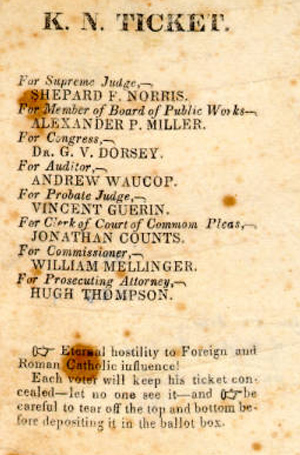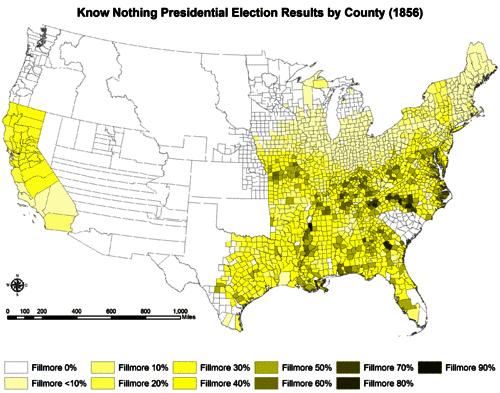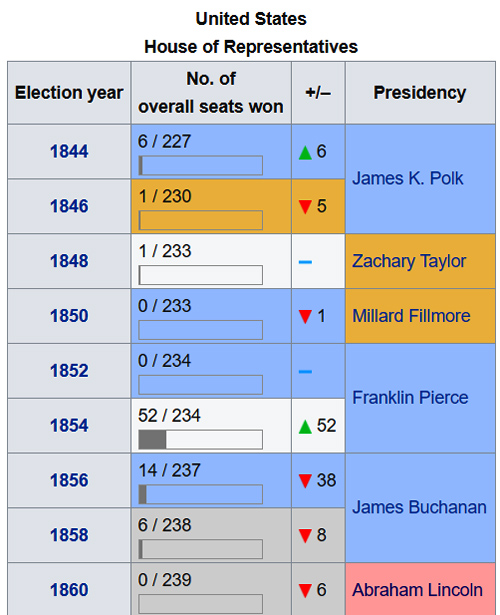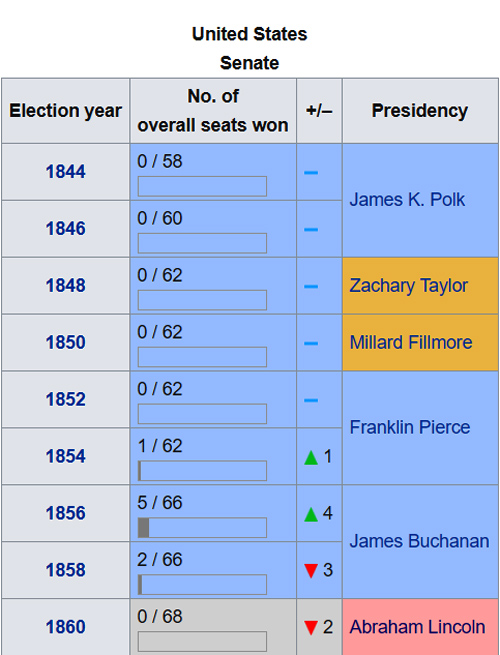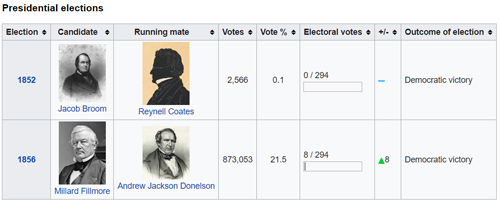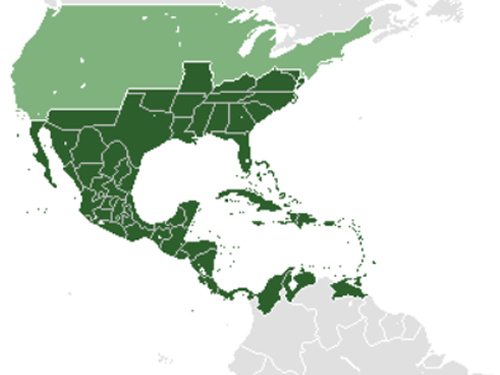Know Nothing
by Wikipedia
Accessed: 2/16/21
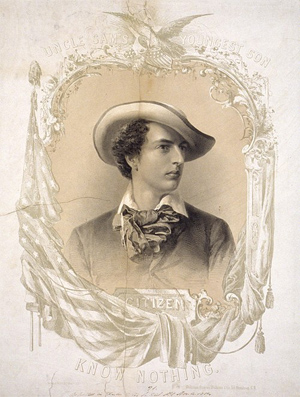
Know Nothing
Uncle Sam's youngest son, Citizen Know Nothing, an 1854 print
Other name: Native American Party (before 1855); American Party (after 1855)
First Leader: Lewis Charles Levin
Founded: 1844; 177 years ago
Dissolved: 1860; 161 years ago
Preceded by: American Republican Party; Whig Party
Succeeded by: Constitutional Union Party; North American Party
Headquarters: New York City
Secret wing: Order of the Star Spangled Banner
Ideology: American nationalism; Nativism; Populism; Republicanism
Religion: Protestantism
Colors: Red White Blue
The Know Nothing movement, formally known as the Native American Party (at that time meaning descendants of colonists or settlers, rather than Indigenous Americans) before 1855 and the American Party after 1855, was a nativist political party and movement in the United States, which operated nationwide in the mid-1850s, originally starting as a secret society. It was primarily an anti-Catholic, Anti-Irish, anti-immigration, populist and xenophobic movement, although it was also progressive in its stances on "issues of labor rights, opposition to slavery, and the need for more government spending"[1] as well as for its "support for an expansion of the rights of women, regulation of industry, and support of measures designed to improve the status of working people."[2] It was also a forerunner to the temperance movement in the United States and its nativist spirit is seen in both the American Protective Association and the Ku Klux Klan.[3]
The American Protective Association (APA) was an American anti-Catholic secret society established in 1887 by Protestants. The organization was the largest anti-Catholic movement in the United States during the later part of the 19th century, showing particular regional strength in the Midwest. The group grew rapidly during the early 1890s before collapsing just as abruptly in the aftermath of the election of 1896.
Unlike the more powerful Know Nothing movement of the 1850s, the APA did not establish its own independent political party, but rather sought to exert influence by boosting its supporters in campaigns and at political conventions, particularly those of the Republican Party. The organization was particularly concerned about Roman Catholic influence in the public school system as well as unfettered Catholic immigration and what was seen as growing Catholic control of the political establishments of major American cities.
Attaining a six-figure membership at its peak in early 1896, the organization's collapse was rapid, with only a hollow shell remaining by 1898. The rump organization was finally terminated in 1911 with the death of its founder.
Establishment
On the afternoon of Sunday, March 13, 1887, a meeting was called in the Clinton, Iowa law office of Henry F. Bowers to discuss the recent electoral defeat of incumbent mayor Arnold Walliker, which Bowers and others blamed on the organized efforts of Roman Catholics in the local organized labor movement.[1] Seven men were in attendance, including the defeated former mayor and his brother.[2] The decision was made by the seven men to establish a new political society to combat Catholic political influence, to be called the American Protective Association, and a constitution and Masonic-influenced ritual was drawn up for this new organization.[3]
Bowers was elected the group's first "Supreme President." Aside from Bowers himself, there were six other founding members. Bowers would later relate that this "First Council" was composed of three Republicans, two Democrats, one Populist, and one Prohibitionist.[4] The religious make-up of the First Council was said by Bowers to include members of the Methodist, Baptist, Presbyterian, Congregationalist, and Lutheran religious denominations, as well as "one of no religion."[4]...
The years 1892 and 1893 initiated a period of dramatic growth in the size of the APA, and the secret society began capturing headlines in newspapers around the country. By September 1893 the head of the Buffalo, New York local council of the APA — formerly a Loyal Orange Institution member from Toronto — boasted of more than 800 members in that city alone, and promised that "we are going to run this city just as the APA runs Kansas City, Detroit, Saginaw, and other cities of the West."[8]...
Growth of the APA during the early 1890s was spurred by the circulation of forged documents, including in particular a set of purported “instructions to Catholics” advising the faithful against "keeping faith with heretics," and another alleged Papal encyclical over the signature of Pope Leo XIII calling for Catholics to "exterminate all heretics" on or about St. Ignatius Day [September 5], 1893.[10]
The Canadian-born W. J. H. Traynor, past Supreme Grand Master of the Loyal Orange Institution of the United States[11] and editor of a weekly anti-Catholic newspaper from Detroit, The Patriotic American,[12] succeeded Bowers as Supreme President in 1893.[4] It would be he who would lead the group during its period of greatest influence during the mid-1890s.[4] Traynor, the son of a building contractor, had joined the Orange Order at the age of 17 and maintained membership and connections with a host of religious and nationalist secret societies, including the Illustrious Order of the Knights of Malta, the American Patriot League, the American Protestant Association, and other similar organizations.[13]...The Loyal Orange Institution, commonly known as the Orange Order, is an international Protestant fraternal order based in Northern Ireland. It also has lodges in England, Scotland and the Republic of Ireland, as well as throughout the British Commonwealth and the United States.[1][2][3] The Orange Order was founded in County Armagh in 1795, during a period of Protestant–Catholic sectarian conflict, as a Masonic-style fraternity sworn to maintain the Protestant Ascendancy. It is headed by the Grand Orange Lodge of Ireland, which was established in 1798. Its name is a tribute to the Dutch-born Protestant Parliament-supported prince William of Orange's defeat of Catholic English king James II in the Williamite–Jacobite War (1688–1691). The order is best known for its yearly marches, the biggest of which is held on or around 12 July (The Twelfth).
The Orange Order is a conservative unionist organisation,[4][5] with links to Ulster loyalism. It campaigned against Scottish independence in 2014.[6] The Order sees itself as defending Protestant civil and religious liberties, whilst critics accuse the Order of being sectarian, triumphalist,[7][8][9][10] and supremacist.[10][11][12][13] As a strict Protestant society, it does not accept non-Protestants as members unless they convert and adhere to the principles of Orangeism, nor does it accept Protestants married to Catholics.[14][15][16] Although many Orange marches are without incident, marches through mainly Catholic and Irish nationalist neighbourhoods are controversial and have often led to violence.[17][18]
-- Orange Order, by Wikipedia
The Association took an active part in the mid-term election of 1894 and off-year elections of 1895, in some jurisdictions running its own ticket, but more often supporting candidates from the main parties who agreed with its agenda. It often took credit for Republican victories, especially in the GOP landslide year of 1894. Thus it took credit with the election of John W. Griggs to the governorship of New Jersey, by bringing up his opponent's, Alexander T. McGill support of a Catholic protection bill in 1875. It also claimed it had an influence in the elections in Upstate New York during the same period.[13] Its leader Traynor said the APA had twenty members of Congress as members; he boasted that one hundred members had been elected by it.[9]
Decline and extinction
In December 1895, the APA played a dominant role in the organization of a convention of patriotic organizations to coordinate efforts in the upcoming 1896 electoral campaign.[17] Joining the APA were representatives of the Loyal Orange Institution, the Junior Order of United American Mechanics, the Society for Protection of American Institutions, and other related groups — organizations which together fancifully claimed some 3 million adherents.[17] The convention adopted a platform calling for restricted immigration, a halt to public money spent for ostensibly sectarian purposes, limitation of the vote to citizens alone, and equal taxation of all except public property, and formed committees to attend the national conventions of the various political parties in an effort to gain commitments for these principles into national party platforms.[18]...
Ideology and program
APA propaganda depicting the Pope as the master decision-maker controlling the White House, Congress, and federal financial and publishing institutions. (Art from an 1894 book.)
While the Association said it did not have any conflict with Catholicism or the Irish per se, they believed that the Roman Catholic Church was making inroads into the government of the United States with the goal of controlling it. They said that Catholics had congregated in areas of large cities, preventing the election of non-Catholics in those areas, that 60% to 90% of government employees were Catholic, often illiterate and current and hired on the basis of patronage, attacks on the public school system, the "remarkable" increase in untaxed church property and the "fact" that the army, navy "were almost entirely Romanized", "frequent desecration" of the American flag by priests and the federal government was controlled by the Jesuits. They said that Roman Catholics were under the complete political control of the Pope and were to required to obey its laws when they were in conflict with those of the state, citing the Papal encyclical issued by Leo XIII on January 10, 1890, Sapientiae Christianae.[21]
The APAs program and stated aims included the "perpetual" separation of Church and State; maintenance of a free, non-sectarian public school system; prohibition of any government grant or special privilege to sectarian bodies; establishment of an educational qualification to vote, "purification of the ballot"; suspension of further immigration, and its resumption on guarantees of residence and educational qualifications; public inspections of all private schools, convents, monasteries, hospitals, educational and reformatory institutions. In New Jersey they were able to sponsor a "School Flag Act" and an act forbidding students from wearing religious garb in school.[22]
Representatives of the group also made public announcements that the Roman Catholic Church had instigated the Civil War, during which they said Catholics and Irish made up large numbers of deserters, and that both Grover Cleveland and William McKinley were controlled by the Church.[23]
Although a veil of secrecy cloaked early doctrinal documents, which later said to have only "feebly indicated" the APA's organizational aims,[24] the 1894 national convention approved a 13-point statement of principles which was made public and published.[25] This platform stated that "loyalty to true Americanism, which knows neither birthplace, race, creed, or party" was the "first requisite for membership" in the APA, and that the organization did not control the political affiliations of its members.[26]
The group's fundamental opposition to Catholicism was spelled out in the third plank of the 1894 statement of principles, which declared that while the APA was "tolerant of all creeds," it nevertheless"holds that subjection to and support of any ecclesiastical power, not created and controlled by American citizens, and which claims equal, if not greater, sovereignty than the government of the United States of America, is irreconcilable with American citizenship. It is therefore opposed to the holding of offices in National, State, or Municipal government by any subject or supporter of such ecclesiastical power."[26]
The program further spelled out the APA's belief that "non-sectarian free public schools" constituted the "bulwark of American institutions" and protested against employment of so-called "subjects of un-American ecclesiastical power" as public school teachers or administrators.[26] The document also called for a "prohibition of the importation of pauper labor" as a means of protecting "our citizen laborers" and for tighter standards in immigration and naturalization law.[26]
Although regarded by historians as a nativist movement,[27] the APA was not automatically hostile to immigrants — quite the contrary. Many members, perhaps a majority, were themselves foreign-born, including Irish Protestants, Britons, and Scandinavian Lutherans.[28] The organization permitted African-Americans to membership, with blacks elected representatives of their state organizations to national conventions of the organization.[29] Segregated local councils for black members were organized in the Southern States in 1895 and 1896, but local councils in the North were integrated.[19] There is no evidence of either widespread participation by Jews in the APA or official anti-Semitism as a part of organizational practice.[29]
Citing immigration figures for the decade of the 1880s, which were said to have shown that 3.25 million of 6.3 million immigrants to America were Roman Catholic, one 1894 APA apologetic moved beyond the standard rationale of Papal political manipulation in arguing for a tightening of immigration standards for reasons of public safety:..."Most all of the better class of immigrants are Protestants. It remains that, almost entirely, the lowest class are Roman Catholics.... Among these are mostly found the train wreckers, robbers, plunderers, murderers, and assassins of the country.... In the large cities criminal statistics show that while Roman Catholics furnish about four percent of the population, they produce more than one-half of the crime, if we except those cities in which there is a large percent of negro criminals."[30]
The APA was also active in Canada, where it is said to have worked with the Orangemen and "is said to have controlled elections in the chief cities of the Dominion in 1894 and 1895." In England they also apparently worked with the Orange Lodge.[19] They were also reportedly active in Australia.[37]
-- American Protective Association, by Wikipedia
The Know Nothing movement briefly emerged as a major political party in the form of the American Party. Adherents to the movement were to simply reply "I know nothing" when asked about its specifics by outsiders, providing the group with its common name.[4]
Supporters of the Know Nothing movement believed that an alleged "Romanist" conspiracy was being planned to subvert civil and religious liberty in the United States, and sought to politically organize native-born Protestants in what they described as a defense of their traditional religious and political values. The Know Nothing movement is remembered for this theme because of fears by Protestants that Catholic priests and bishops would control a large bloc of voters. I n most places, the ideology and influence of the Know Nothing movement lasted only a year or two before disintegrating due to weak and inexperienced local leaders, a lack of publicly declared national leaders, and a deep split over the issue of slavery. In the South, the party did not emphasize anti-Catholicism as frequently as it did in the North and stressed a neutral position on slavery,[5] but it became the main alternative to the dominant Democratic Party.[4]
The collapse of the Whig Party after the passage of the Kansas–Nebraska Act left an opening for the emergence of a new major political party in opposition to the Democratic Party. The Know Nothing movement managed to elect congressman Nathaniel P. Banks of Massachusetts and several other individuals in the 1854 elections into office, and subsequently coalesced into a new political party known as the American Party. Particularly in the South, the American Party served as a vehicle for politicians opposed to the Democrats. Many also hoped that it would stake out a middle ground between the pro-slavery positions of Democratic politicians and the radical anti-slavery positions of the rapidly emerging Republican Party. The American Party nominated former President Millard Fillmore in the 1856 presidential election, although he kept quiet about his membership, and personally refrained from supporting the Know Nothing movement's activities and ideology. Fillmore received 21.5% of the popular vote in the 1856 presidential election, finishing behind the Democratic and Republican nominees.[6]
The party entered a period of rapid decline after Fillmore's loss in the 1856 presidential election and the Dred Scott v. Sandford decision of the Supreme Court of the United States in 1857 further galvanized opposition to slavery in the North, causing many former Know Nothings to join the Republicans.[7] The remnants of the American Party largely became part of the Constitutional Union Party in 1860 and disappeared during the American Civil War.
The Constitutional Union Party was a United States third party active during the 1860 elections. It consisted of conservative former Whigs, largely from the Southern United States, who wanted to avoid secession over the slavery issue and refused to join either the Republican Party or the Democratic Party. The Constitutional Union Party campaigned on a simple platform "to recognize no political principle other than the Constitution of the country, the Union of the states, and the Enforcement of the Laws".
The Whig Party had collapsed in the 1850s due to a series of sectional crises over slavery. Though some former Whigs joined the Democratic Party or the new, anti-slavery Republican Party, others joined the nativist American Party [Know Nothing Party]. The American Party entered a period of rapid decline following the 1856 elections, and in the lead-up to the 1860 elections John J. Crittenden and other former Whigs founded the Constitutional Union Party. The 1860 Constitutional Union Convention met in May 1860, nominating John Bell of Tennessee for president and Edward Everett of Massachusetts for vice president. Party leaders hoped to force a contingent election in the House of Representatives by denying any one candidate a majority in the Electoral College.
The 1860 election essentially consisted of two campaigns, as Republican nominee Abraham Lincoln competed with Northern Democratic candidate Stephen A. Douglas in the North, and Bell competed with Southern Democratic candidate John C. Breckinridge in the South. Ultimately, Lincoln won the election by winning nearly every Northern electoral vote. Bell took 12.6% of the nationwide popular vote, carried three states in the Upper South, and finished with the second highest vote total in each remaining slave state that held a popular vote. After the election, Crittenden and other Constitutional Unionists unsuccessfully sought to prevent a civil war with the Crittenden Compromise and the Peace Conference of 1861. Bell declared his support for the Confederacy following the Battle of Fort Sumter, but many other Constitutional Unionists remained loyal to the Union throughout the American Civil War.
-- Constitutional Union Party (United States), by Wikipedia
History
Anti-Catholicism had been a factor in colonial America but played a minor role in American politics until the arrival of large numbers of Irish and German Catholics in the 1840s.[8] It then reemerged in nativist attacks on Catholic immigration. It appeared in New York City politics as early as 1843 under the banner of the American Republican Party.[9]
The American Republican Party was a minor anti-Catholic, anti-immigration and nativist political organization that was launched in New York in June 1843, largely as a protest against immigrant voters and officeholders.
In 1844, the American Republican Party carried municipal elections in New York City and Philadelphia and expanded so rapidly that by July 1845 a national convention was called. This convention changed the name to the Native American Party and drafted a legislative program calling for a twenty-one-year period preceding naturalization and other sweeping reforms in the immigration policy. Failure to force congressional action on these proposals, combined with the growing national interest in the Mexican problem before the Mexican–American War, led to the party's rapid decline.
Its founders included Lewis Charles Levin, Samuel Kramer, "General" Peter Sken Smith, James Wallace, and John Gitron.
-- American Republican Party (1843), by Wikipdia
The movement quickly spread to nearby states using that name or Native American Party or variants of it. They succeeded in a number of local and Congressional elections, notably in 1844 in Philadelphia, where the anti-Catholic orator Lewis Charles Levin, who went on to be the first Jewish congressman, was elected Representative from Pennsylvania's 1st district. In the early 1850s, numerous secret orders grew up, of which the Order of United Americans[10] and the Order of the Star Spangled Banner[11] came to be the most important. They emerged in New York in the early 1850s as a secret order that quickly spread across the North, reaching non-Catholics, particularly those who were lower middle class or skilled workmen.[12]
The Order of the Star Spangled Banner (OSSB) was an oath-bound secret society in New York City. It was created in 1849 by Charles B. Allen to protest the rise of Irish, Catholic, and German immigration into the United States.
To join the Order, a man had to be at least 21 years old, a Protestant, and willing to obey the Order's dictates without question. Members were Nativists, citizens opposed to immigration, especially by Catholics. They saw Catholics as dangerous, illegal voters under the control of the Pope in Rome. Members invariably responded to questions about the OSSB by claiming that they "knew nothing." This practice caused newspaper editor Horace Greeley to label them "Know Nothings." The OSSB would eventually form the nucleus of the nativist Know Nothing movement which ran candidates in 1855–56 under the American Party ticket.
According to The American Pageant:
Older-stock Americans ... professed to believe that in due time the "alien riffraff" would "establish" the Catholic church at the expense of Protestantism and would introduce "popish idols." The noisier American "nativists" rallied for political action. ... They promoted a lurid literature of exposure, much of it pure fiction. The authors, sometimes posing as escaped nuns, described the shocking sins they imagined the cloisters concealed, including the secret burial of babies. One of these sensational books – Maria Monk's Awful Disclosures (1836) – sold over 300,000 copies.
-- Order of the Star Spangled Banner, by Wikipedia
The name Know Nothing originated in the semi-secret organization of the party. When a member was asked about his activities, he was supposed to reply, "I know nothing." Outsiders derisively called them "Know Nothings", and the name stuck. In 1855, the Know Nothings first entered politics under the American Party label.[13][14]
Underlying issues
The immigration of large numbers of Irish and German Catholics to the United States in the period between 1830 and 1860 made religious differences between Catholics and Protestants a political issue. Violence occasionally erupted at the polls. Protestants alleged that Pope Pius IX had put down the failed liberal Revolutions of 1848 and that he was an opponent of liberty, democracy and republicanism. One Boston minister described Catholicism as "the ally of tyranny, the opponent of material prosperity, the foe of thrift, the enemy of the railroad, the caucus, and the school".[15][16] These fears encouraged conspiracy theories regarding papal intentions of subjugating the United States through a continuing influx of Catholics controlled by Irish bishops obedient to and personally selected by the Pope.
In 1849, an oath-bound secret society, the Order of the Star Spangled Banner, was created by Charles B. Allen in New York City. At its inception, the Order of the Star Spangled Banner only had about 36 members. Fear of Catholic immigration led to a dissatisfaction with the Democratic Party, whose leadership in many cities included Catholics of Irish descent. Activists formed secret groups, coordinating their votes and throwing their weight behind candidates sympathetic to their cause:
Immigration during the first five years of the 1850s reached a level five times greater than a decade earlier. Most of the new arrivals were poor Catholic peasants or laborers from Ireland and Germany who crowded into the tenements of large cities. Crime and welfare costs soared. Cincinnati's crime rate, for example, tripled between 1846 and 1853 and its murder rate increased sevenfold. Boston's expenditures for poor relief rose threefold during the same period.[17]
Rise
In spring 1854, the Know Nothings carried Boston and Salem, Massachusetts, and other New England cities. They swept the state of Massachusetts in the fall 1854 elections, their biggest victory. The Whig candidate for mayor of Philadelphia, editor Robert T. Conrad, was soon revealed as a Know Nothing as he promised to crack down on crime, close saloons on Sundays and to appoint only native-born Americans to office—he won by a landslide. In Washington, D.C., Know Nothing candidate John T. Towers defeated incumbent Mayor John Walker Maury, causing opposition of such proportion that the Democrats, Whigs, and Freesoilers in the capital united as the "Anti-Know-Nothing Party". In New York, in a four-way race the Know Nothing candidate ran third with 26%. After the 1854 elections, they exerted decisive influence in Maine, Indiana, Pennsylvania, and California, but historians are unsure about the accuracy of this information due to the secrecy of the party, as all parties were in turmoil and the anti-slavery and prohibition issues overlapped with nativism in complex and confusing ways. They helped elect Stephen Palfrey Webb as mayor of San Francisco and J. Neely Johnson as governor of California. Nathaniel P. Banks was elected to Congress as a Know Nothing candidate, but after a few months he aligned with Republicans. A coalition of Know Nothings, Republicans and other members of Congress opposed to the Democratic Party elected Banks to the position of Speaker of the House.
The results of the 1854 elections were so favorable to the Know Nothings, up to then an informal movement with no centralized organization, that they formed officially as a political party called the American Party, which attracted many members of the now nearly defunct Whig party as well as a significant number of Democrats. Membership in the American Party increased dramatically, from 50,000 to an estimated one million plus in a matter of months during that year.[18]
The historian Tyler Anbinder concluded:
The key to Know Nothing success in 1854 was the collapse of the second party system, brought about primarily by the demise of the Whig Party. The Whig Party, weakened for years by internal dissent and chronic factionalism, was nearly destroyed by the Kansas–Nebraska Act. Growing anti-party sentiment, fueled by anti-slavery sentiment as well as temperance and nativism, also contributed to the disintegration of the party system. The collapsing second party system gave the Know Nothings a much larger pool of potential converts than was available to previous nativist organizations, allowing the Order to succeed where older nativist groups had failed.[19]
In San Francisco, a Know Nothing chapter was founded in 1854 to oppose Chinese immigration—members included a judge of the state supreme court, who ruled that no Chinese person could testify as a witness against a white man in court.[20]
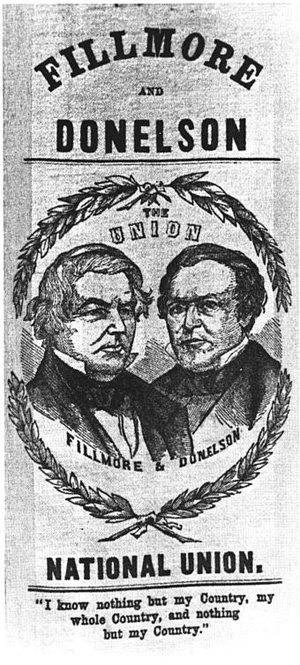
Fillmore–Donelson campaign poster
In the spring of 1855, Know Nothing candidate Levi Boone was elected mayor of Chicago and barred all immigrants from city jobs. Abraham Lincoln was strongly opposed to the principles of the Know Nothing movement, but did not denounce it publicly because he needed the votes of its membership to form a successful anti-slavery coalition in Illinois.[21][22] Ohio was the only state where the party gained strength in 1855. Their Ohio success seems to have come from winning over immigrants, especially German-American Lutherans and Scots-Irish Presbyterians, both hostile to Catholicism. In Alabama, Know Nothings were a mix of former Whigs, discontented Democrats and other political outsiders who favored state aid to build more railroads. Virginia attracted national attention in its tempestuous 1855 gubernatorial election. Democrat Henry Alexander Wise won by convincing state voters that Know Nothings were in bed with Northern abolitionists. With the victory by Wise, the movement began to collapse in the South.[23][24]
Know Nothings scored victories in Northern state elections in 1854, winning control of the legislature in Massachusetts and polling 40% of the vote in Pennsylvania. Although most of the new immigrants lived in the North, resentment and anger against them was national and the American Party initially polled well in the South, attracting the votes of many former southern Whigs.[25]
The party name gained wide but brief popularity. Nativism became a new American rage: Know Nothing candy, Know Nothing tea, and Know Nothing toothpicks appeared. Stagecoaches were dubbed "The Know Nothing". In Trescott, Maine, a shipowner dubbed his new 700-ton freighter Know Nothing.[26] The party was occasionally referred to, contemporaneously, in a slightly pejorative shortening, "Knism."[27]
Leadership and legislation
Historian John Mulkern has examined the party's success in sweeping to almost complete control of the Massachusetts legislature after its 1854 landslide victory. He finds the new party was populist and highly democratic, hostile to wealth, elites and to expertise, and deeply suspicious of outsiders, especially Catholics. The new party's voters were concentrated in the rapidly growing industrial towns, where Yankee workers faced direct competition with new Irish immigrants. Whereas the Whig Party was strongest in high income districts, the Know Nothing electorate was strongest in the poor districts. They expelled the traditional upper-class, closed, political leadership, especially the lawyers and merchants. In their stead, they elected working-class men, farmers and a large number of teachers and ministers. Replacing the moneyed elite were men who seldom owned $10,000 in property.[28]
Nationally, the new party leadership showed incomes, occupation, and social status that were about average. Few were wealthy, according to detailed historical studies of once-secret membership rosters. Fewer than 10% were unskilled workers who might come in direct competition with Irish laborers. They enlisted few farmers, but on the other hand they included many merchants and factory owners.[29] The party's voters were by no means all native-born Americans, for it won more than a fourth of the German and British Protestants in numerous state elections. It especially appealed to Protestants such as the Lutherans, Dutch Reformed and Presbyterians.[30]
The most aggressive and innovative legislation came out of Massachusetts, where the new party controlled all but three of the 400 seats—only 35 had any previous legislative experience. The Massachusetts legislature in 1855 passed a series of reforms that "burst the dam against change erected by party politics, and released a flood of reforms."[31] Historian Stephen Taylor says that in addition to nativist legislation, "the party also distinguished itself by its opposition to slavery, support for an expansion of the rights of women, regulation of industry, and support of measures designed to improve the status of working people".[2]
It passed legislation to regulate railroads, insurance companies and public utilities. It funded free textbooks for the public schools and raised the appropriations for local libraries and for the school for the blind. Purification of Massachusetts against divisive social evils was a high priority. The legislature set up the state's first reform school for juvenile delinquents while trying to block the importation of supposedly subversive government documents and academic books from Europe. It upgraded the legal status of wives, giving them more property rights and more rights in divorce courts. It passed harsh penalties on speakeasies, gambling houses and bordellos. It passed prohibition legislation with penalties that were so stiff—such as six months in prison for serving one glass of beer—that juries refused to convict defendants. Many of the reforms were quite expensive; state spending rose 45% on top of a 50% hike in annual taxes on cities and towns. This extravagance angered the taxpayers, and few Know Nothings were reelected.[32]
The highest priority included attacks on the civil rights of Irish Catholic immigrants. After this, state courts lost the power to process applications for citizenship and public schools had to require compulsory daily reading of the Protestant Bible (which the nativists were sure would transform the Catholic children). The governor disbanded the Irish militias and replaced Irish holding state jobs with Protestants. It failed to reach the two-thirds vote needed to pass a state constitutional amendment to restrict voting and office holding to men who had resided in Massachusetts for at least 21 years. The legislature then called on Congress to raise the requirement for naturalization from five years to 21 years, but Congress never acted.[33] The most dramatic move by the Know Nothing legislature was to appoint an investigating committee designed to prove widespread sexual immorality underway in Catholic convents. The press had a field day following the story, especially when it was discovered that the key reformer was using committee funds to pay for a prostitute. The legislature shut down its committee, ejected the reformer, and saw its investigation become a laughing stock.[34][35][36][37]
The Know Nothings also dominated politics in Rhode Island, where in 1855 William W. Hoppin held the governorship and five out of every seven votes went to the party, which dominated the Rhode Island legislature.[38] Local newspapers such as The Providence Journal fueled anti-Irish and anti-Catholic sentiment.[38]


